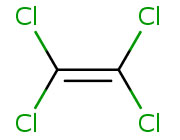Section 1.1. What Is Tetrachloroethylene?
Learning Objectives
After completing this section, you will be able to
- define tetrachloroethylene and
- describe uses of tetrachloroethylene
Properties
- Tetrachloroethylene is a synthetic chemical.
- It is a clear, colorless, nonflammable liquid with a sweet odor and a low aqueous solubility.
- It is volatile and readily evaporates at room temperature.

Figure 1. Chemical structure of tetrachloroethylene – https://toxnet.nlm.nih.gov/cgi-bin/sis/search/a?dbs+hsdb:@term+@DOCNO+124
Use
A recent evaluation of end-use pattern for tetrachloroethylene [ATSDR 2015] estimated the following frequencies of use:
- Chemical intermediates — 60%
- Dry cleaning and textile processing — 18%
- Metal degreasing — 18%
- Oil refining catalyst regeneration — 2%
- Miscellaneous uses including consumer products— 2%
Other uses for tetrachloroethylene [EPA 2005] include
- an intermediate in the synthesis of fluorocarbons,
- an insulating/cooling fluid in electric transformers,
- a component in typewriter correction fluids,
- a veterinary medication against worms, and
- a grain protectant and fumigant.
Synonyms
Chemical synonyms for tetrachloroethylene include
- tetrachloroethene,
- perchloroethylene,
- 1,1,2,2-tetrachloroethylene, and
- ethylene tetrachloride.
Other commonly used names are
- PCE,
- perc,
- perchlor, and
- perclene.